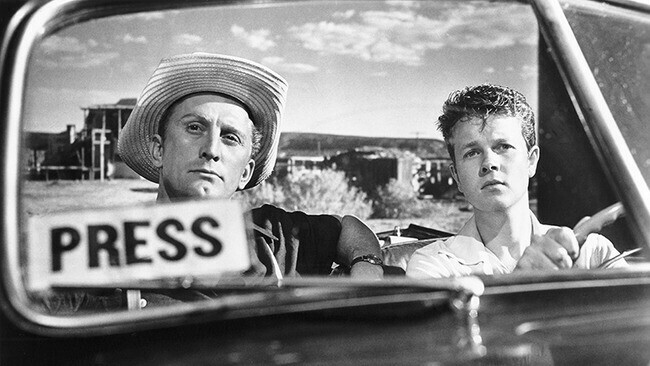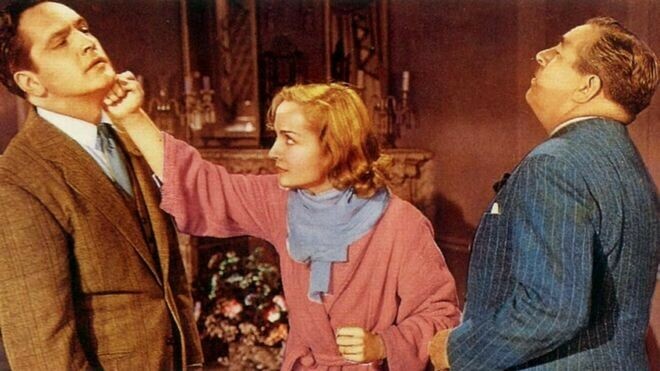News & Articles
Browse all content by date.

My very favorite movie line of all time is uttered by Jan Sterling as Lorraine, the cynical wife of Leo Minosa, a guy trapped in the collapse of an ancient Indian cave dwelling in Billy Wilder’s Ace in the Hole (1951).
Kirk Douglas stars as fallen ace reporter Chuck Tatum, stuck in the boondocks of Albuquerque, New Mexico. When he and his Jimmy Olsen-like photographer are sent to cover a rattlesnake hunt, they stumble upon a story Tatum knows will get him back into the big time – Leo Minosa trapped inside an Indian cave with a curse on it.
He manipulates everyone involved and the story to meet his ends.
At one point Tatum advises Lorraine to go to church and pray for Leo because it would be good for the story.
“I don’t go to church. Kneeling bags my nylons,” Lorraine deadpans.
Yup, greatest line ever!
This treasure is among the new Criterion Channel collection Read All About It! – 16 films about the inky business where I’ve spent my life. Consider this my Thanksgiving tribute to the crazy business that has kept food on my table for most of my adult life.
But be forewarned. It’s a quirky business, and a lot of the characters in these movies aren’t always the likable kind.
The collection kicks off with Five Star Final (1931), starring Edward G. Robinson as Joseph Randall, editor of the Gazette. The Gazette owner wants Randall to tone down his highbrow tendencies such as putting the League of Nations on the front page when he believes readers want more “human interest,” stuff Randall refers to as “slop.” He calls his boss “the Sultan of Slop.”
Nonetheless, Randall is forced to counter a circulation decline by pursuing a “human interest” story that results in a double suicide. The lead reporter, an insect-like man named Izzipod, is played to creepy perfection by Boris Karloff.
Robinson repeats the age-old newspaperman line after his newspaper has caused two deaths – “I’ve been in this game for too long to be ashamed of myself.”
Newspaper magnate William Randolph Hearst was reportedly deeply offended by the movie and thought it was directed at him and the yellow journalism that his newspaper empire was known for, but I’m sure that was nothing to how he felt a decade later with Orson Welles’ Citizen Kane, which was most definitely modeled after him (although it is a great newspaper movie, Citizen Kane is not among this collection).
Also from 1931 is a movie from a stage play by two famous Chicago newspapermen – The Front Page by Ben Hecht and Charles MacArthur. It stars Pat O’Brien as ace reporter Hildy Johnson, who plans to quit his newspaper job to marry a socialite, and Adolphe Menjou as Hildy’s cutthroat editor Walter Burns, who needs him to cover a hanging.
Menjou is especially good here as the conniving Burns. I love his acting, but as a human being he was a despicable right-wing crackpot.

Frederic March, Carole Lombard and Walter Connolly in William Wellman’s Nothing Sacred (1937).
There are so many things to like about this movie – the fast-paced dialogue, the cavalcade of goofball newspapermen in the courthouse press room, and, most importantly, for an anarchic moment that I have described to people these many years and that was missing in the Criterion version I just watched.
I looked for the moment – a very lazy banjo-playing reporter played by Phil Tead is in the press room alone when the mayor and sheriff come in. He walks between them toward the camera, saying “Hi Mayor. Hi Sheriff,” with middle fingers raised.
When I did not find it on the Criterion edition, I began to doubt my memory. It had been a long time since I’d seen it. Perhaps I had misremembered the scene.
Upon deeper reflection, I knew my memory was correct. But what I did not know until just now is that two versions of this movie were made – one for domestic consumption and another for European release. I bet somewhere I have the VHS with the flipping-off version (the Euro version, is my guess).
If you can find the finger version, get it. It makes a huge difference. The scene in the Criterion version has the reporter approaching the two officials, but the reporter says something so innocuous and without the finger salute that you wonder, why is that scene there?
I’m going to go out of sequence here to mention the 1940 gender-switch remake of The Front Page by Howard Hawks, His Girl Friday, starring Rosalind Russell as ace reporter Hildy Johnson and Cary Grant as editor, and former husband, Walter Burns.
Director Hawks was determined to break the record for fastest screen dialogue, which was held by The Front Page. In order to achieve that end, he encouraged improvisational riffing that paid off with the breakneck pace of this fun movie.
Appearing chronologically after The Front Page and still from the productive year of 1931 is Frank Capra’s Platinum Blonde, starring the amazing Jean Harlow, who seems so natural and made for the screen in this film. Her co-star is Robert Williams, a reporter who is sent to get the scoop on the socialite Harlow plays. Williams died three days after the Oct. 31, 1931, release of this film.
Also in the cast for comic relief is Robert Catlett, who has a fairly prominent reporter role in The Front Page.

Barbara Stanwyck as reporter Ann Mitchell and Gary Cooper as Long John Willoughby/John Doe in the final scene’s of Frank Capra’s newspaper/Christmas movie Meet John Doe.
Then we move on to 1932 and Blessed Event, with the fast-talking Lee Tracy as gossip columnist Alvin Roberts, based on real-life blabbermouth Walter Winchell, whose euphemism for pregnancy without benefit of marriage was “a blessed event, without benefit of clergy.”
Clark Gable and Claudette Colbert are up next in Frank Capra’s 1934 wisecracking rom-com It Happened One Night. Beloved upon its release and first winner of the Oscar Grand Slam (Best Picture, Actor, Actress, Director and Screenplay – an achievement that did not happen again until One Flew Over the Cuckoo’s Nest in 1975), it holds up well.
However, my favorite Capra movie is in this lineup, his 1941 Meet John Doe has been a Christmas staple for me for years because I consider it more of a Christmas movie than a newspaper movie. It stars Gary Cooper as a drifter who accepts the proposal of newspaper columnist Barbara Stanwyck and her editor James Gleason to become a disgruntled character – John Doe – the creation of Stanwyck, an unemployed man so dissatisfied with modern American life at the time – just about to enter a world war – that John Doe vowed to commit suicide on Christmas Eve.
This is Capra’s darkest vision of America, with a media that would do anything for circulation, the rich who would do anything for more power and a public dopey enough to fall for anything. This was made 80 years ago, folks, yet it sounds contemporary.
But let’s back up a minute, to 1937 and William Wellman’s Technicolor Nothing Sacred, a black comedy about unscrupulous newspapers and citizens. Frederic March plays disgraced reporter Wallace Cook, who has been relegated to the obituary desk. Desperate to get back in the good graces of his boss, he asks to be allowed to tell the story of Hazel Flagg (Carole Lombard), a young woman who was misdiagnosed with radiation poisoning. March brings the not-dying young woman to New York and makes her the toast of the town.
Ben Hecht wrote the script and packed it with witty gags. Lots of sight gags, too. My favorite moments are when Cook arrives in the Vermont town where Hazel lives and is greeted by a series of taciturn Vermonters. Fun stuff.
Also fun is the first of eight movie pairings of Spencer Tracy and Katharine Hepburn in the 1942 Woman of the Year, with Tracy as a sports reporter and Hepburn a political reporter on the same newspaper.
Elia Kazan’s 1947 Gentleman’s Agreement follows, starring Gregory Peck as a reporter for a liberal magazine who takes an assignment to write about anti-semitism, but can’t find a way into the story until he decides to pretend to be Jewish.
It’s the magazine owner (played by Albert Dekker) who wants the story written because, he says, “There just isn’t anything bigger than beating down the complacence of essentially decent people about racism.”
Seventy-five years later, the message of this movie remains relevant.
Samuel Fuller’s Park Row (1952) is basically a love letter to the newspaper business, starring Gene Evans as an uncompromising newspaperman who starts a new publication from scratch.
Also from 1952 is Scandal Sheet starring Broderick Crawford as a selfish newspaper editor who accidentally kills the wife he had abandoned 20 years before.
Then we jump to the year 1977 for Between the Lines, directed by Joan Micklin Silver. First I’ve ever heard of this movie about a Boston-area alternative newspaper and its mostly counter-culture staff. Among the ensemble cast are John Heard, Lindsey Crouse, Bruno Kirby, Joe Morton, Marilu Henner, Jeff Goldblum and Michael J. Pollard. It features a blatantly ‘70s soundtrack featuring an abundance of electric piano and Southside Johnny and the Asbury Jukes.
For the final two films we go to Australia (well, Indonesia in the final one, but by Australian director Peter Weir).
Newsfront (1978) by Philip Noyce is a fascinating drama set between 1948 and 1956, when newsreels shown at movie theaters were overtaken by TV.
And, finally, Weir’s 1982 The Year of Living Dangerously, with Mel Gibson, Sigourney Weaver and Linda Hunt.
I question why these two movies about the broadcasting business are included with all the newspaper movies. Surely they could have stuck to the theme.
And because newspaper journalists consider themselves a different breed entirely from broadcast journalists, I am not going to touch those last two worthy movies right now.
| Tweet |


